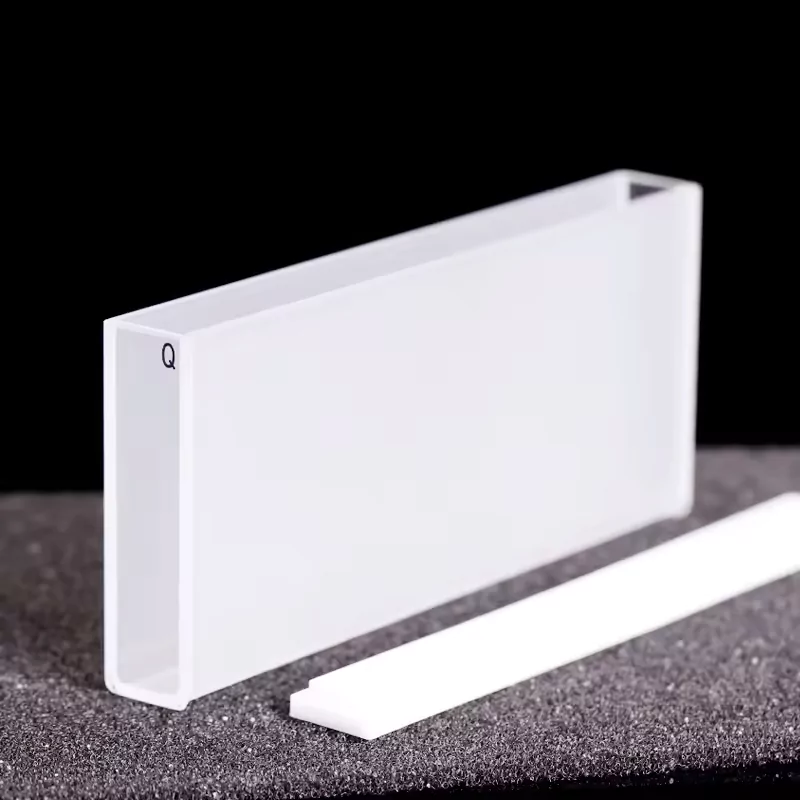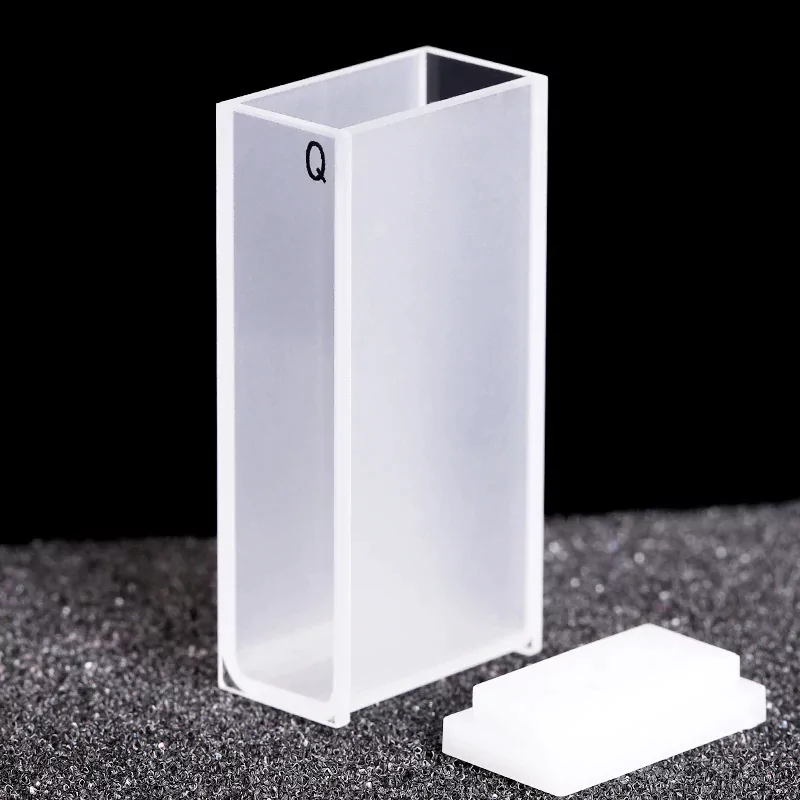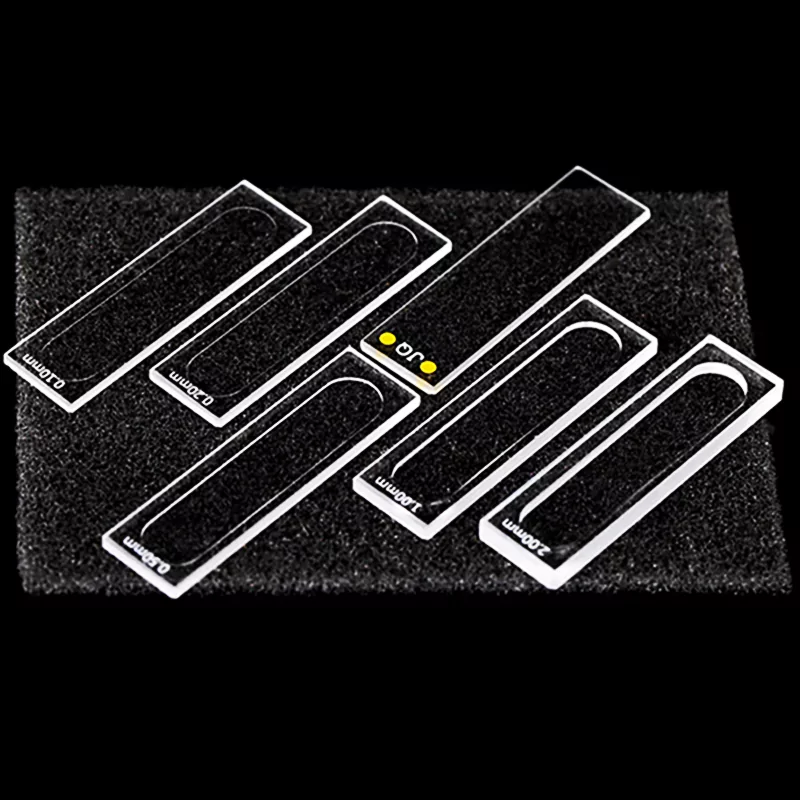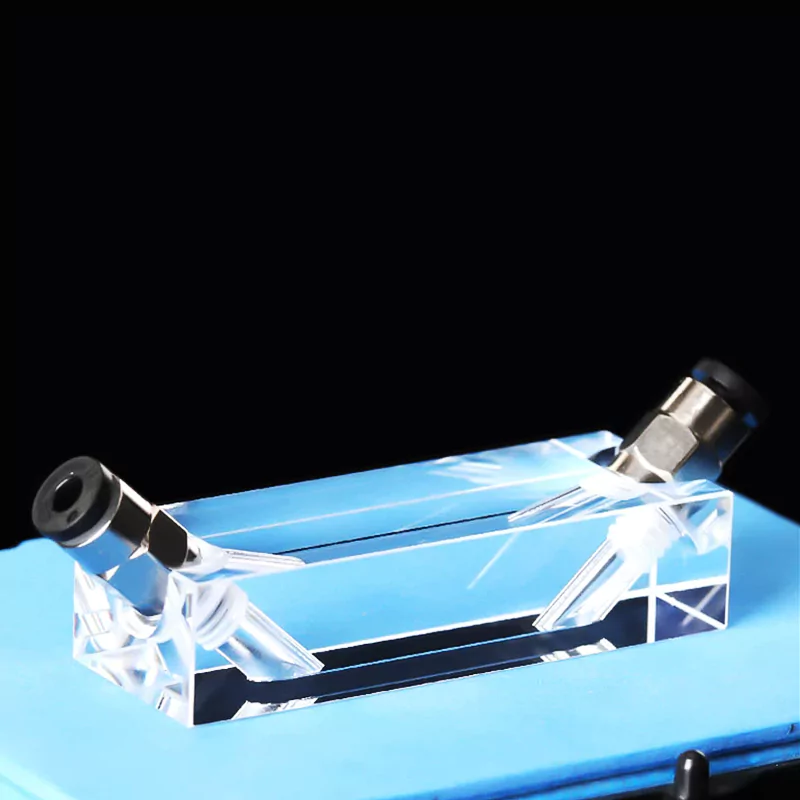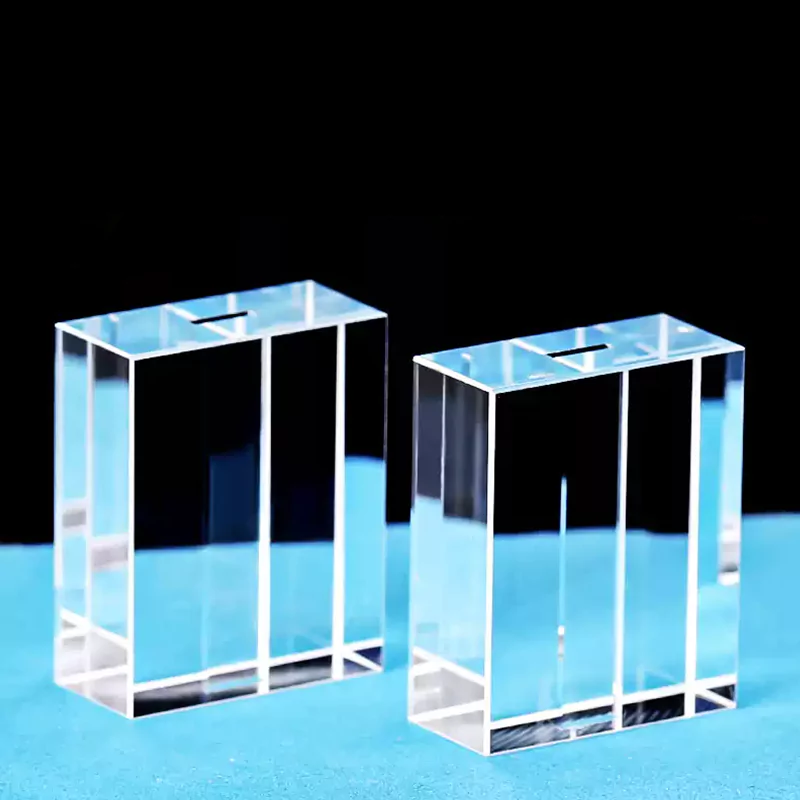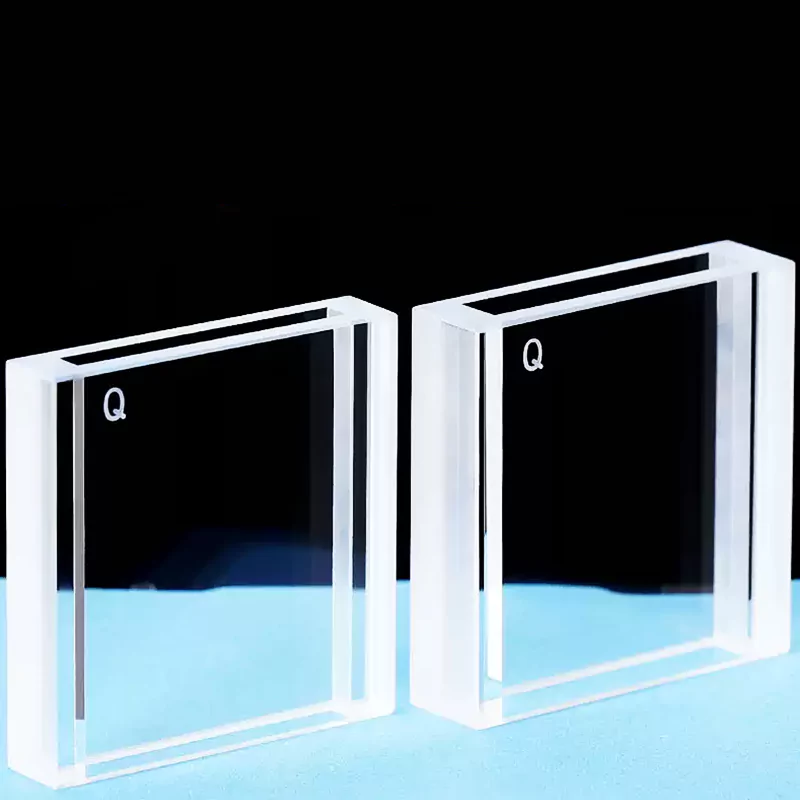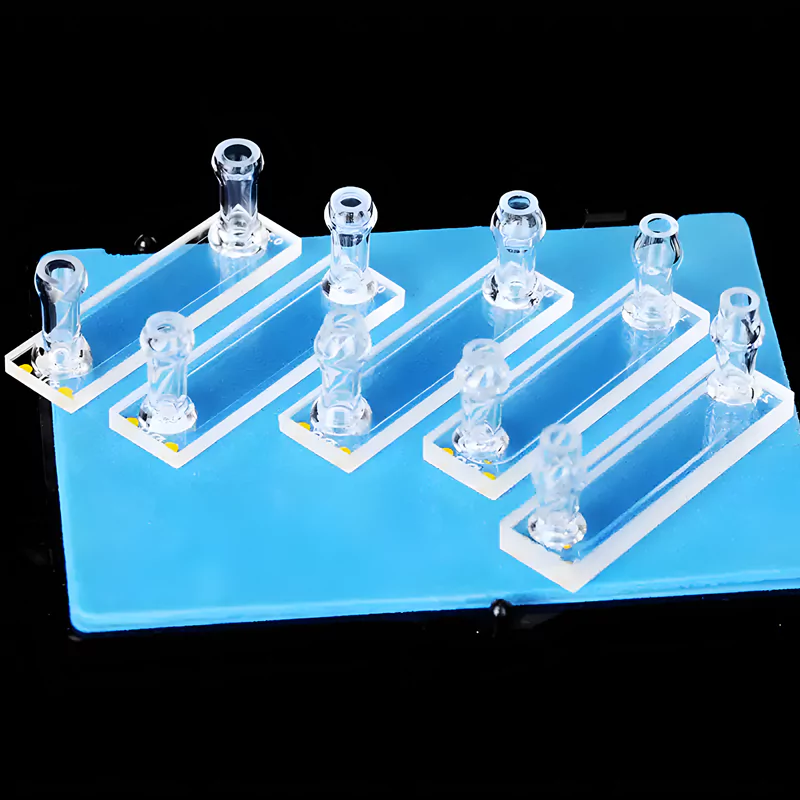- Home
- /
- Types
- /
- Quartz Cuvette
- /
- Quartz UV Cuvette
- /
- Quartz Cuvette with Two...
Quartz Cuvette with Two Optical Windows and PTFE Lid for UV-Vis Spectrophotometer-TOQUARTZ®
Features of Quartz Cuvette with Two Optical Windows and PTFE Lid
TOQUARTZ® quartz cuvettes with two optical windows and PTFE lids are manufactured from high-purity fused quartz, offering excellent optical, thermal, and chemical properties for demanding laboratory applications.
Material Properties
- High-purity fused quartz (≥99.98% SiO₂)
- Thermal resistance up to 1100°C
- Chemical resistance to acids, bases, and solvents
- Low thermal expansion coefficient (5.5×10⁻⁷ /°C)
Optical Properties
- Wide spectral transparency (200-2500nm)
- Two precisely polished optical windows
- High transmittance (>80% in paired testing)
- Low light scattering for accurate measurements
Practical Design
- PTFE lid provides secure sealing
- Multiple volume option
- Various path lengths

- Material: Fused Quartz (≥99.98% SiO₂)
- Wavelength: 200-2500nm
- Transmittance: >80% (Paired)
Technical Specifications & Dimensions of Quartz Cuvette with Two Optical Windows and PTFE Lid
Technical Specifications
| Property | Value |
| 1. Physical Properties | |
| Density | 2.2 g/cm³ |
| Fracture Modulus | ≥350 MPa |
| Thermal Expansion | 5.5×10-7/℃ |
| Thermal Conductivity | 1.4 W/m·K |
| Max Operating Temp | 1100°C |
| 2. Chemical Properties | |
| SiO2 Purity | ≥99.98% SiO2 |
| Acid Resistance | Excellent (except HF) |
| Alkali Resistance | Good up to pH 12 |
| Solvent Resistance | Excellent |
| Water Absorption | Nil |
| 3. Optical Properties | |
| Transmittance | >80% (200-2500nm) |
| Refractive Index | 1.46 at 589.3nm |
| Surface Quality | Polished optical windows |
| UV Cutoff | ~180-190nm |
| Optical Windows | Two sides polished |
Size Chart

| Model | Description | Wavelength | Path Length | Volume | Transmittance | Outline Dimension |
| AT-BSM-052 | 7ml Quartz Cuvette Cell with 2 Optical Windows and Lid | 200nm-2500nm | 20mm | 7ml | >80% (Paired Testing) | 12.5×22.5×45 mm |
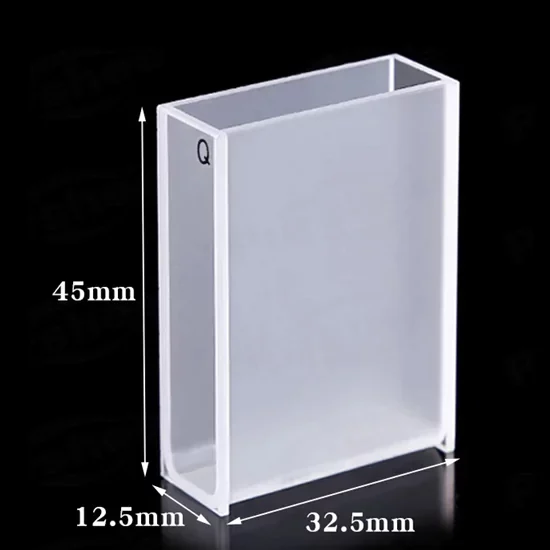
| Model | Description | Wavelength | Path Length | Volume | Transmittance | Outline Dimension |
| AT-BSM-073 | 10.5ml Quartz Cuvette Cell with 2 Optical Windows and Lid | 200nm-2500nm | 30mm | 10.5ml | >80% (Paired Testing) | 12.5*32.5*45mm |

| Model | Description | Wavelength | Path Length | Volume | Transmittance | Outline Dimension |
| AT-BSM-072 | 14ml Quartz Cuvette Cell with 2 Optical Windows and Lid | 200nm-2500nm | 40mm | 14ml | >80% (Paired Testing) | 12.5×42.5×45 mm |

| Model | Description | Wavelength | Path Length | Volume | Transmittance | Outline Dimension |
| AT-BSM-004 | 17.5ml Quartz Cuvette Cell with 2 Optical Windows and Lid | 200nm-2500nm | 50mm | 17.5ml | >80% (Paired Testing) | 12.5×42.5×45 mm |
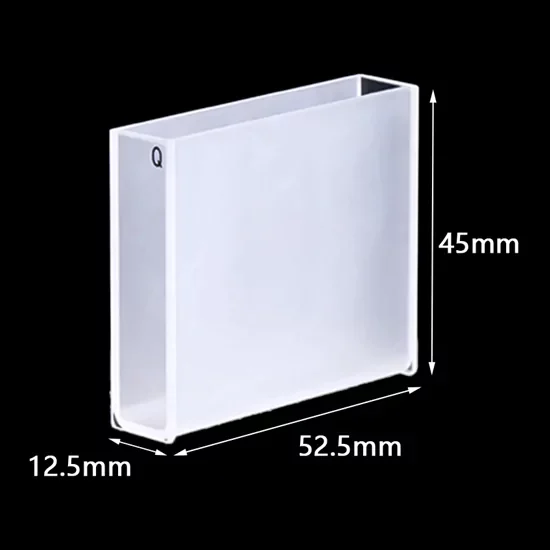
| Model | Description | Wavelength | Path Length | Volume | Transmittance | Outline Dimension |
| AT-BSM-008 | 17.5ml Quartz Cuvette Cell with 2 Optical Windows and Lid | 200nm-2500nm | 50mm | 17.5ml | >80% (Paired Testing) | 12.5×52.5×45 mm |

| Model | Description | Wavelength | Path Length | Volume | Transmittance | Outline Dimension |
| AT-BSM-006 | 35ml Quartz Cuvette Cell with 2 Optical Windows and Lid | 200nm-2500nm | 100mm | 35ml | >80% (Paired Testing) | 12.5×102.5×45 mm |
TOQUARTZ® Solving Challenges with Quartz Cuvette with Two Optical Windows and PTFE Lid
Quartz Cuvette with Two Optical Windows and PTFE Lid for Pharmaceutical Analysis
Key Advantages
-
Certified low-leach PTFE sealing
PTFE lid tested to leach <0.01 ppm into aqueous solutions over 72h at 25°C. -
UV transmission stability under repeated sterilization
Maintains >80% transmittance at 260nm after 50 autoclave cycles at 121°C. -
Batch-to-batch optical consistency for QC reproducibility
Paired cuvettes show <0.3% deviation in absorbance at 280nm across 100-unit lots.
TOQUARTZ® solution
A pharmaceutical QC lab in Frankfurt faced inconsistent absorbance readings due to lid contamination and cuvette variability, delaying batch release. After switching to TOQUARTZ cuvettes, they achieved <0.5% RSD at 260nm across 30 samples, reducing retest rate by 92% and saving €9,800/month in QC labor and material costs.
Fused Quartz Cuvette with Two Optical Windows and PTFE Lid for Academic Research
Key Advantages
-
Multi-path length availability for protocol flexibility
Available in 20mm–100mm path lengths to support kinetic, titration, and low-concentration assays. -
Optical window flatness tolerance ≤0.01mm
Ensures consistent beam alignment in dual-beam spectrophotometers across replicates. -
PTFE lid compatibility with volatile organic solvents
No deformation or leakage observed after 48h exposure to methanol, ethanol, and DMSO.
TOQUARTZ® solution
A U.S. university lab conducting protein-ligand binding studies reported cuvette warping and signal drift using plastic-lid cells. TOQUARTZ cuvettes maintained dimensional stability and signal integrity over 60 runs, enabling publication of reproducible data in Analytical Biochemistry with <2% deviation in KD values.
Quartz Cuvette with Two Optical Windows and PTFE Lid for Environmental Analysis
Key Advantages
-
Acid-resistant PTFE lid for aggressive sample matrices
No degradation after 72h exposure to 10% HNO₃ and 5% HCl at 40°C. -
Extended path length (100mm) for trace detection
LOD improved by 8.6× in nitrate analysis at 220nm compared to 10mm cuvettes. -
Anti-adsorption quartz surface finish
<0.5% analyte retention for heavy metals (Pb²⁺, Cd²⁺) after 3 rinse cycles.
TOQUARTZ® solution
An environmental lab in Ontario struggled with poor sensitivity in UV nitrate detection due to short path cuvettes and sample carryover. After adopting TOQUARTZ 100mm cuvettes, they achieved detection limits of 0.02 mg/L NO₃⁻ and eliminated cross-sample contamination, meeting new provincial water testing standards.
Customization Services for TOQUARTZ® Quartz Cuvette with Two Optical Windows and PTFE Lid
Dimensional Customization
- Custom path lengths
- Specialized inner dimensions for specific sample volumes
- Non-standard outer dimensions to fit specific instruments
- Tolerance precision to ±0.1mm
Optical Customization
- Additional polished windows (3 or 4 sides)
- Black-walled options for fluorescence applications
- Anti-reflection coatings for specific wavelengths
- Frosted non-optical surfaces to reduce stray light
Functional Customization
- Alternative lid materials (PE, glass, quartz)
- Flow-through ports for continuous sampling
- Graduated markings for volume indication
- Custom identification markings
TOQUARTZ® Engineering Support for Your Project
Free technical consultation
Prototype development with fast turnaround
Small batch trials before full production
Comprehensive quality testing and documentation
Usage Guide of Quartz Cuvette with Two Optical Windows and PTFE Lid
Handling and Measurement
-
Optical window handling:
Always hold the cuvette by the non-optical sides to prevent fingerprints and contamination on the optical windows. -
Orientation:
Ensure the optical windows are positioned perpendicular to the light path in your spectrophotometer. -
Sample filling:
Fill to approximately 2/3 capacity to allow for thermal expansion while ensuring the light path passes through the sample. -
Lid sealing:
Secure the PTFE lid firmly but without excessive force to prevent sample evaporation. -
Temperature equilibration:
Allow samples to reach thermal equilibrium before measurement for the most accurate results.
Cleaning Procedures
-
Immediate rinse:
Rinse with appropriate solvent immediately after use to prevent sample residue buildup. -
Standard cleaning:
For routine cleaning, use mild detergent solution followed by thorough rinsing with distilled water. -
Organic residues:
Remove with acetone or methanol, followed by distilled water rinse. -
Persistent contaminants:
Soak in 10% nitric acid solution (except for fluoride-containing samples), then rinse thoroughly. -
Drying:
Air dry in dust-free environment or use filtered compressed air/nitrogen. -
Optical window cleaning:
For precision measurements, clean optical windows with lens tissue and spectroscopic-grade solvent.
-
IMPORTANT:
Never use hydrofluoric acid (HF) for cleaning as it will etch and damage quartz surfaces.
Storage
-
Dry storage:
Store cleaned and dried cuvettes in a dust-free environment. -
Protective cases:
Use the provided storage case or a dedicated cuvette rack. -
Avoid contact:
Prevent contact between optical windows and hard surfaces to prevent scratches.
Extending Cuvette Lifespan
Need Expert Advice on Quartz Cuvettes?
Why Partner with TOQUARTZ
Direct Factory Advantage
As a direct manufacturer, we can cut out the numerous intermediate links.
Engineering Expertise
Technical team guides clients from material selection to design optimization, translating specs into deliverables.
Flexible Manufacturing
Handling standard & custom orders via small-batch expertise and prototyping rigor to meet urgent deadlines.
Quality
Assurance
Pre-shipment 3-step validation:
1. dimensional accuracy,
2. material purity ,
3. performance thresholds
Global Supply Chain
Reliable global logistics to industrial hubs (DE/US/JP/KR priority) with trackable milestones.
Releted Products
As a specialized manufacturer with direct factory capabilities, TOQUARTZ provides both standard and custom quartz solutions with engineering support throughout the specification and implementation process.
FAQ
Q: Why do I need a PTFE lid on my quartz cuvette?
A: PTFE lids provide several benefits: they prevent sample evaporation during measurement, reduce contamination risk, protect against dust and airborne particles, and enable secure storage of samples. The chemical inertness of PTFE ensures it won’t react with your samples or release contaminants.
Q: What path length should I choose for my application?
A: Path length selection depends on your sample concentration and absorbance range. For high-concentration samples, shorter path lengths (1-10mm) are recommended. For dilute solutions or low-absorbing compounds, longer path lengths (20-100mm) provide better sensitivity. Standard spectrophotometers typically use 10mm, while our range offers 20-100mm options for specialized needs.
Q: How do I clean my quartz cuvette without damaging it?
A: Clean immediately after use by rinsing with appropriate solvent. For routine cleaning, use mild detergent followed by distilled water rinse. For stubborn residues, use acetone, methanol, or dilute nitric acid (except for fluoride-containing samples). Never use hydrofluoric acid (HF). Dry with filtered air or in a dust-free environment. Handle only by non-optical sides.
Q: Are these cuvettes compatible with my spectrophotometer?
A: TOQUARTZ® standard models are compatible with most common spectrophotometers. For specialized instruments, we offer custom dimensions to ensure proper fit. Please provide your instrument make and model when ordering, and our technical team will confirm compatibility or recommend appropriate customizations.
Q: What is the difference between two optical windows and four optical windows?
A: Two-window quartz cuvettes have polished optical surfaces on opposite sides, ideal for standard transmission measurements in UV-Vis spectrophotometry. Four-window cuvettes have all four sides polished, allowing measurements from multiple angles and are particularly useful for fluorescence, where excitation and emission light paths are perpendicular.
Contact our engineering team for technical consultation and pricing. We’ll help you select the optimal specifications for your application requirements.



